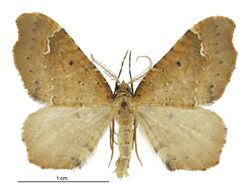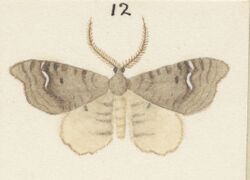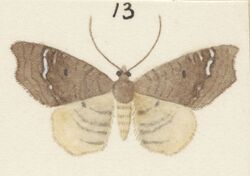Biology:Asaphodes camelias
| Asaphodes camelias | |
|---|---|

| |
| Female | |

| |
| Male | |
| Scientific classification | |
| Domain: | Eukaryota |
| Kingdom: | Animalia |
| Phylum: | Arthropoda |
| Class: | Insecta |
| Order: | Lepidoptera |
| Family: | Geometridae |
| Genus: | Asaphodes |
| Species: | A. camelias
|
| Binomial name | |
| Asaphodes camelias (Meyrick, 1888)[1]
| |
| Synonyms[2] | |
| |
Asaphodes camelias is a species of moth in the family Geometridae.[3] It is endemic to New Zealand, has been observed in both the North and South Islands and inhabits native forest. The adults of this species are on the wing from February to May and July to September.
Taxonomy
This species was first described by Edward Meyrick in 1888 as Larentia camelias using a male specimen collected at the Whangārei Heads in December.[4] George Hudson discussed this species in his 1898 book under the name Xanthorhoe camelias and again, as well as illustrating the species, in his 1928 publication.[5][6] In 1971 J. S. Dugdale placed this species in the genus Asaphodes.[7] This placement was affirmed by Dugdale in 1988.[2] The male holotype specimen is held at the Natural History Museum, London.[2]
Description
Meyrick described this species as follows:
Male. — 23 mm. Head, antennae, and thorax whitish-ochreous, greyish-tinged, with a few dark fuscous scales. Palpi fuscous. Abdomen whitish-ochreous, with a double dorsal series of dark fuscous dots. Legs whitish-ochreous, irrorated with purple-reddish and dark fuscous. Forewings with costa rather sinuate in middle, on anterior half gently, on posterior half very strongly arched, hindmargin moderately sinuate below apex, bowed in middle ; light greyish-ochreous, with numerous cloudy waved brown-grey transverse lines, somewhat bent near costa ; a black discal dot ; margin of basal patch and anterior edge of median band indicated by series of very minute white dots, preceded and followed by black points ; posterior edge of median band marked by a darker line, followed by a fine white line reduced on lower half to a series of points ; subterminal line represented by four cloudy blackish dots on upper half and another above anal angle : cilia greyish-ochreous (imperfect). Hindwings fuscous-whitish ; a median band of four cloudy greyish lines, bent near costa ; a cloudy grey spot above anal angle ; cilia fuscous-whitish (imperfect).[4]
Distribution
This species is endemic to New Zealand.[1] Specimens of this species have been collected in the southern North Island hill country,[8] as well as near the Waitaha River[9] and at Paroa,[10] both in the South Island. A. camelias is regarded a typical species of the West Coast region.[10]
Behaviour
The adults of this species are on the wing from February to May and July to September.[10]
Habitat
This species inhabits native forest.[6]
References
- ↑ 1.0 1.1 "Asaphodes camelias (Meyrick, 1888)". Landcare Research New Zealand Ltd. http://www.nzor.org.nz/names/8084b31e-a7dc-4ec9-8a67-ae3cbf6b950d.
- ↑ 2.0 2.1 2.2 , pp. 172, Wikidata Q45083134
- ↑ Gordon, Dennis P., ed (2010). New Zealand inventory of biodiversity. Volume two. Kingdom animalia : chaetognatha, ecdysozoa, ichnofossils. 2. Christchurch, N.Z.: Canterbury University Press. pp. 458. ISBN 9781877257933. OCLC 973607714.
- ↑ 4.0 4.1 , pp. 58, Wikidata Q108281219
- ↑ , pp. 65, Wikidata Q19073637
- ↑ 6.0 6.1 , pp. 114, Wikidata Q58593286
- ↑ , Wikidata Q64006453
- ↑ McGregor, P. G.; Watts, P. J.; Esson, M. J. (1987). "Light trap records from southern North Island hill country.". New Zealand Entomologist 10 (1): 104–121. doi:10.1080/00779962.1987.9722515.
- ↑ Toft, R. (April 2014). Potential Effects of the Waitaha Hydro Scheme on Terrestrial Invertebrates (Report). Entecol Ltd. p. 17. http://www.westpower.co.nz/system/files/resources/Appendix%2018%20-%20WHS%20-%20Invertebrate%20Report.pdf. Retrieved 20 August 2017.
- ↑ 10.0 10.1 10.2 Lyford, Brian M. (1994). "Lepidoptera and Trichoptera from Paroa, near Greymouth, New Zealand.". New Zealand Entomologist 17 (1): 46–51. doi:10.1080/00779962.1994.9721984. ISSN 0077-9962.
External links
Wikidata ☰ Q37410044 entry
 |



